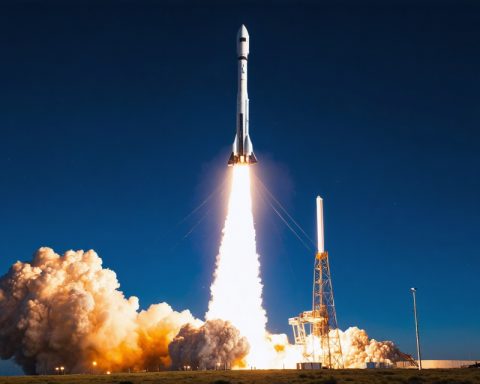- The X-59 jet, developed by NASA and Lockheed Martin, aims to revolutionize supersonic air travel by minimizing the noise of a sonic boom to a “sonic thump.”
- Engineered to travel at 924 mph and cruise at 55,000 feet, the X-59 features a distinctive design with a stiletto-like nose to reduce noise impact.
- The jet’s innovative engineering includes the F414-GE-100 engine placement, reducing the sonic impact to as gentle as a toilet flushing (75 decibels).
- Plans are in place for a 2025 launch, but exact timelines remain uncertain.
- The project represents a significant step towards quieter, more environmentally friendly aerospace technology.
In the dry, crusted landscape of the desert, a sleek machine poised under the sun promises to silence the cacophony of supersonic travel. NASA, in collaboration with Lockheed Martin, has completed the latest ground tests of the X-59—a strikingly futuristic jet that looks set to redefine air travel. The jet is no ordinary aircraft; it promises to transform the thunderous sonic boom of supersonic speed into a mere whisper, aptly named the “sonic thump.”
With the world eager to witness this technological marvel, the X-59, with its elegant, stiletto-like nose, is engineered to cruise at a blistering 924 mph. Imagine standing beneath vast skies, where this machine will soar at an altitude of 55,000 feet, slicing through the atmosphere. Gone will be the days of windows rattling as if gripped by an invisible fury; gone will be the panic stirred in livestock by deafening noise. The X-59’s sound will be as gentle as a toilet flushing, a mere 75 decibels compared to the obnoxious roar of the Concorde.
This magic doesn’t just lie in its design, but also in its engineering, like the carefully placed F414-GE-100 engine perched atop the plane, a strategic choice to muzzle the noise before it touches the earth.
Anticipation builds as the aviation world waits—yet the timeline remains as elusive as the soft thump it hopes to create. 2025 is earmarked for the skyward journey, but as with any pathbreaking expedition, patience is key. For now, gazes are fixed skyward, dreams tethered to the quiet promise of the X-59. It’s not just a flight—it’s a quiet revolution.
The Future of Quiet Supersonic Travel: Discover the X-59’s Potential
How-To Steps & Life Hacks: Understanding Supersonic Travel
1. Breaking Down the Boom: Supersonic aircraft like the X-59 are designed to travel faster than the speed of sound. However, this speed creates a sonic boom as pressure waves compress and release. Current methods to mitigate this noise involve innovative aerodynamic designs and strategic engine placements, such as those seen in the X-59.
2. Engineering Insights: Harnessing computer simulations and wind tunnel tests, engineers can fine-tune the aircraft’s shape to control shock waves generated by supersonic speeds, converting the explosive boom into a softer “thump.”
3. Regulatory Navigation: Supersonic flights over land are restricted in many countries due to noise concerns. Understanding these regulations is crucial for companies aiming to deploy such technology commercially. This makes NASA’s research on reducing sonic booms vital for policy advancement.
Real-World Use Cases
– Commercial Air Travel: The X-59 aims to revitalize commercial supersonic travel by making it viable over populated areas, potentially reducing flight times between cities significantly.
– Military Applications: The technology could enhance military aircraft capabilities by allowing stealthier and faster missions.
Market Forecasts & Industry Trends
– The global supersonic travel market is poised to grow as companies like Boom Supersonic and Aerion Corporation join the race. Analysts predict the market could be worth billions by the 2030s as airlines and travelers seek faster travel options.
Reviews & Comparisons
– X-59 vs. Concorde: The Concorde was loud and fuel-inefficient compared to the X-59’s designs that focus on noise reduction and fuel efficiency.
Controversies & Limitations
– Environmental Impact: Despite noise reduction, supersonic jets may still face scrutiny over fuel consumption and emissions. Sustainable aviation fuels and electric propulsion are areas of ongoing research to address these concerns.
Features, Specs & Pricing
– Specs: The X-59 is designed to reach speeds of up to 924 mph at 55,000 feet. The aircraft utilizes the F414-GE-100 engine, specially configured for noise reduction.
– Pricing: Development costs are significant, potentially reaching hundreds of millions. However, the price of future commercial versions will be key to wider adoption.
Security & Sustainability
– Noise Management: The “silent” supersonic boom is achieved through precise engineering, ensuring that the X-59 meets noise restrictions and can travel overland.
– Fuel Efficiency: While the X-59 has made strides in noise reduction, its environmental impact remains under examination. Innovations will be crucial for sustainable operations.
Insights & Predictions
– Industry Adoption: If successful, the technology behind the X-59 could lead to new policies allowing commercial supersonic travel, drastically altering international travel landscape.
– Technological Advancements: Continued advancements in aerodynamics and sustainable fuel technology will further enable the viability and environmental acceptance of supersonic aircraft.
Pros & Cons Overview
Pros:
– Reduced noise compared to traditional supersonic aircraft.
– Faster travel times, potentially revolutionizing air travel.
Cons:
– High development and operational costs.
– Environmental and regulatory hurdles still need addressing.
Actionable Recommendations
– Stay Updated: Follow news from aviation leaders and NASA to learn about breakthroughs in supersonic travel.
– Understand Impacts: Consider both the environmental and economic implications of supersonic technology in travel planning or project development.
– Engage in Policy Discussions: Businesses and individuals should participate in forums about aviation regulations to shape the future of quiet supersonic travel.
Explore more about aviation and innovation at NASA or check out the latest industry trends from Lockheed Martin.







